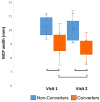Middle Cerebellar Peduncle Width-A Novel MRI Biomarker for FXTAS?
- PMID: 29988561
- PMCID: PMC6026659
- DOI: 10.3389/fnins.2018.00379
Middle Cerebellar Peduncle Width-A Novel MRI Biomarker for FXTAS?
Abstract
Fragile X-associated tremor/ataxia syndrome (FXTAS) is a severe neurodegenerative movement disorder affecting over 40% of male and 16% of female FMR1 premutation carriers over the age of 50. However, there is a lack of prognostic biomarkers to aid early diagnosis and treatment planning. Therefore, this study aimed to assess the utility of the Magnetic Resonance Parkinson Index (MRPI) as a potential MRI biomarker for FXTAS. The four measurements required for the MRPI were assessed in 45 male premutation carriers at risk of developing FXTAS (Mean age = 59.54 years), 53 male patients with FXTAS (Mean age = 66.16 years) and 61 male controls (Mean age = 60.75 years), of which 73 participants had follow-up visits on average 1.96 years later. Middle cerebellar peduncle (MCP) width as well as midbrain and pons cross-sectional area were reduced in patients with FXTAS compared to both premutation carriers without FXTAS and controls. While these measurements were not found to change over time in the three-group analysis, age was an important predictor of midbrain cross-sectional area and pons/midbrain ratio. MCP width was initially reduced in a subset of premutation carriers who developed FXTAS symptoms between their initial and follow-up visits, which also decreased between visits, compared to age-matched premutation carriers who did not show any FXTAS symptom development over time. Therefore, while the MPRI may not be a useful biomarker for FXTAS, decreased MCP width may be one of the first notable signs of FXTAS, and therefore the first biomarker with the potential to identify those most at risk for the disorder.
Keywords: FXTAS; MRI; biomarkers; fragile X; middle cerebellar peduncle.
Figures



References
-
- Bacalman S., Farzin F., Bourgeois J. A., Cogswell J., Goodlin-Jones B. L., Gane L. W., et al. . (2006). Psychiatric phenotype of the fragile X-associated tremor/ataxia syndrome (FXTAS) in males: newly described fronto-subcortical dementia. J. Clin. Psychiatry 67, 87–94. 10.4088/JCP.v67n0112 - DOI - PubMed
-
- Brunberg J. A., Jacquemont S., Hagerman R. J., Berry-Kravis E. M., Grigsby J., Leehey M. A., et al. . (2002). Fragile X premutation carriers: characteristic MR imaging finding of adult male patients with progressive cerebellar and cognitive dysfunction. Am. J. Neuroradiol. 23, 1757–1766. - PMC - PubMed
Grants and funding
LinkOut - more resources
Full Text Sources
Other Literature Sources
Miscellaneous

